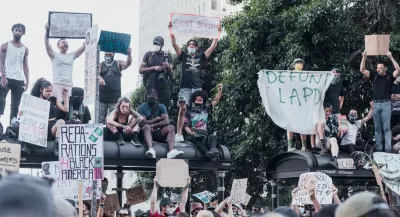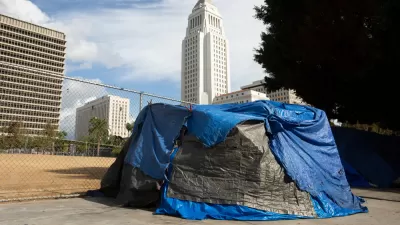The "Metro as Sanctuary" campaign provides an example of movement-based planning. This kind of planning is relational and solidaristic, with an emphasis on collective decision-making, complementary divisions of labor, and mutual learning.

The subject of reparation has gained greater salience and traction in popular and planning discourse. A recent episode of Last Week Tonight with John Oliver culminated with a discussion of reparations. Examining the history of racially discriminatory housing policies and industry practices in the United States, the comedian and late-night news commentator concluded, "The only really strange thing about paying reparations to Black people is that we haven't done it."He elaborated: "The right thing to do couldn't be clearer. When you deprive somebody of something, you make it right by paying what you owe."
At the national level, Ta-nehisi Coates' "The Case for Reparations" prominently implicated modern planning apparatuses in the country's history of racial violence and dispossession. As examined by Joan Fitzgerald in a recent Planetizen article, "The Beginning of Housing Reparations," local and state governments are beginning to address the racial wealth gap by passing reparations resolutions, making funding appropriations, and enacting other measures that seek to repair histories of harm—encompassing enslavement, discriminatory housing and lending policies, destructive highway and infrastructure projects, and more. Reparative planning has become a key topical area among planning researchers and scholars as well, gaining overdue consideration and treatment as part of a special issue of the Journal of American Planning Association focused on "Anti-Racist Futures."
The fight for reparation encompasses a long history of activism and movement building as recounted in the article "Reparations— Has the Time Finally Come?" written by Nkechi Taifa. As early as 1783, Belinda Royall petitioned the Massachusetts General Court for remuneration of her uncompensated labor. Subsequent milestones include the 1898 founding of the National Ex-Slave Mutual Relief Bounty and Pension Association, which sought compensation for slavery from federal agencies; the Universal Negro Improvement Association’s transatlantic reparation and repatriation schemes in the 1920s; the adoption of the "Black Manifesto" at the 1969 National Black Economic Development Conference demanding reparations from white churches to Black Americans; and the founding of the National Coalition of Blacks for Reparations in America (NCOBRA) in 1987. Reparations measures, beginning with HR40 - Commission to Study and Develop Reparation Proposals for African-Americans Act (1988), were only made possible by the tireless organizing and advocacy of formerly enslaved people, their descendants, and accomplices.
If reparation is "abolition in action," as stated by Patrisse Cullors, cofounder of Black Lives Matter, it seems appropriate to consider reparative planning in light of abolitionist planning debates. In 2017, a group of graduate students at UCLA co-facilitated a course, "Abolitionist Planning in Today’s Political Conjuncture," and published an abolitionist planning guide for urban planners. Deshonay Dozier’s "A Response to Abolitionist Planning" (2018) raised the intractable question of whether professional planning could actually contribute to abolition, conceived as a movement and verb (continuing actions) seeking to end prisons, policing, and border walls, given the field's complacency in the reproduction of institutional violence. Warning against token inclusivity and participation that dissipate popular resistance and co-opt abolitionist, Black, Brown, and Indigenous knowledge, Dozier invites planners to actively subvert planning education and practices while building liberatory movements and advancing non-reformist reforms.
Indeed, planners have not been at the forefront of abolitionist, reparative, and otherwise anti-racist movements, but they have not lacked for planning. Robin D.G. Kelley’s Freedom Dreams (2003) offers fascinating insight into the transformative values, bold imaginaries, and affirmative principles animating the four-centuries long dream of reparations for slavery and Jim Crow. Nor is movement-based planning a thing of the past. In the Bronx, where residents have organized for decades— across neighborhoods, generations, lines of race, gender, class, ethnicity, immigration status, and faith—a borough-wide coalition recently engaged thousands of Bronxites in a year-long community-driven planning process to create the Bronx People's Platform. This collective vision of systemic solutions to inequality grounded in an economic democracy framework is intended to inform organizing efforts across the borough for equitable, sustainable, and just development; hold elected officials accountable; and direct policy and investment in the borough toward the long-term shared ownership and collective governance of Bronx-based assets.
The Alliance for Community Transit - Los Angeles (ACT-LA) offers another instructive example of movement-based planning for non-reformist reforms—with significant outcomes achieved over its ten-year trajectory. With origins in the L.A.-based movement for community benefits, the regional coalition of 41 community-based organizations combines grassroots organizing, coalition building, and direct-action campaigns to make L.A. accessible and affordable to all—especially low-income communities and communities of color. Its past successes include the passage of Measure JJJ- Build Better LA (2016), which established the landmark Transit-Oriented Communities (TOC) policy for the city of Los Angeles that has enabled 32,000 units of housing proposed near transit, nearly 7,100 of which are affordable, with a portion geared to extremely low-income families. Among ACT-LA’s ongoing campaigns, "Metro as Sanctuary" aims to shift funding from the Los Angeles County Metropolitan Transportation Authority's (Metro) multi-agency law enforcement contract to instead fund critical investments in job creation, inclusive safety services, and rider-friendly active spaces that promote holistic safety for all L.A. County residents.
At the invitation of ACT-LA’s director, Laura Raymond, three graduate-level urban planning and architecture students and I joined the "Metro as Sanctuary" campaign alongside other university-based allies such as the Veterans Legal Clinic at UCLA School of Law and the Movement Lawyering Clinic at Howard University School of Law. Through summer and fall 2020—in the midst of the pandemic—ACT-LA organizers, coalition members, and allies held virtual teach-ins, workshops, and meetings, in part to co-create the "Metro as Sanctuary" policy proposal and advocacy campaign. My team of planners and designers—including Anne Lin (MUP, MPH 2021), Elifmina Mizrahi (MUP 2021), and Fiona Riley (MArch 2022)— was tasked with developing the environmental design component of the policy proposal to promote safety on public transit beyond the punitive, police-first model. The experience destabilized and informed our understanding of reparative planning in ways that decentered planning as a profession but not as a creative, invocative endeavor.
A distinct attribute of the Metro as Sanctuary campaign work was that it was relational and solidaristic. Compared to mainstream planning organizations and venues, we noticed an emphasis on collective decision-making, complementary divisions of labor, and mutual learning and deep emphasis on individual leadership and authorship. Notwithstanding the impressive professional credentials of coalition members and allies, they appeared secondary to shared goals and priorities emanating from the lived experiences of L.A.’s low-income communities and communities of color. The mutual input and feedback helped mitigate personal biases and blindspots, which have otherwise pervaded planning policies and histories of harm. It also better aligned the policy proposal and campaign strategies with the goals and moral grounding of other local and regional movement-based initiatives that also center working-class communities of color such as Alternatives to Incarceration Initiative and Healthy LA.
Throughout the campaign, we noticed careful attention paid to power. Beyond the spatialization of white supremacy and intersecting oppressions through the urban built environment, infrastructure investments, and redevelopment projects, ACT-LA members and organizers often referenced past and ongoing community-led struggles and political formations for equitable development. It was clear that the member organizations brought diverse specializations that were complementary in building collective power across sectors and scales, and ACT-LA convened a counter space in which to unlearn, organize, and co-create in autonomous terms separate from public meetings and other existing spaces held by planning authorities. In contrast to prevalent assumptions among planners that politics make only incremental reforms possible, we witnessed a more flexible understanding of politics. The coalition combined a keen awareness of regional political dynamics with an understanding of pressure points or points of entry for progressive action and the existing relationships and influence to effectively reimagine and reiterate transit safety beyond policing.
Where some of the allied lawyers identified as movement lawyers, we didn’t have a pre-existing category to name the work we were doing but came to identify similarly—as movement-based planners. Our entry into the Metro as Sanctuary campaign came at a time when we were growing tired of anti-racist statements, displays of symbolic solidarity, and reading lists and roundtables otherwise dominating the field and profession in the wake of uneven pandemic effects and mass protests in defense of Black lives. We found relief and renewal in simply showing up, listening out, and contributing to the campaign as needed—with research, planning and design provocations, communication materials, or simply taking minutes—and knowing that our work was a small part of a much larger formation. The present reparation measures led by government agencies and officials are necessary but insufficient; history reminds us that reparation, or abolition in action, is built on social movements, which call us to action.
Lily Song is an assistant professor of Race and Social Justice in the Built Environment at Northeastern University. She was formerly lecturer in Urban Planning and Design and founding coordinator of CoDesign at the Harvard Graduate School of Design.

Planetizen Federal Action Tracker
A weekly monitor of how Trump’s orders and actions are impacting planners and planning in America.

Maui's Vacation Rental Debate Turns Ugly
Verbal attacks, misinformation campaigns and fistfights plague a high-stakes debate to convert thousands of vacation rentals into long-term housing.

San Francisco Suspends Traffic Calming Amidst Record Deaths
Citing “a challenging fiscal landscape,” the city will cease the program on the heels of 42 traffic deaths, including 24 pedestrians.

Amtrak Rolls Out New Orleans to Alabama “Mardi Gras” Train
The new service will operate morning and evening departures between Mobile and New Orleans.

The Subversive Car-Free Guide to Trump's Great American Road Trip
Car-free ways to access Chicagoland’s best tourist attractions.

San Antonio and Austin are Fusing Into one Massive Megaregion
The region spanning the two central Texas cities is growing fast, posing challenges for local infrastructure and water supplies.
Urban Design for Planners 1: Software Tools
This six-course series explores essential urban design concepts using open source software and equips planners with the tools they need to participate fully in the urban design process.
Planning for Universal Design
Learn the tools for implementing Universal Design in planning regulations.
Heyer Gruel & Associates PA
JM Goldson LLC
Custer County Colorado
City of Camden Redevelopment Agency
City of Astoria
Transportation Research & Education Center (TREC) at Portland State University
Jefferson Parish Government
Camden Redevelopment Agency
City of Claremont





























